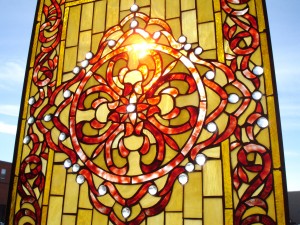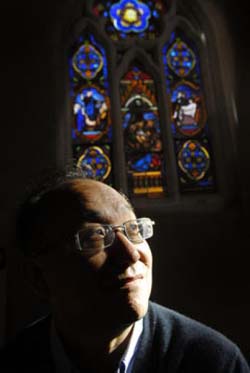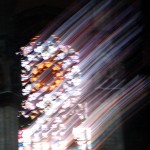
A crimson golden stained glass window.
I’ve often wondered if there was a connection between art, science, and even history. I am thrilled to have discovered that there indeed is. Hearing of how people in Europe incorporated nanoparticles in their lives in one of my lectures blossomed my interest on the subject. After some research, I found that recently announced in nanotech news is the fact that stained glass windows in churches offer air purification properties. Windows painted with gold have the ability to purify the air when the particles come in contact with direct sunlight, according to a team of nanotech researchers from Queensland University of Technology. The glaziers found in medieval forges were some of the very first nanotechnology specialists capable of creating colors with various gold nanoparticles of numerous sizes, says Associate Professor Zhu Huai Yong of the university.

Associate Professor Zhu Huai Yong, from Queensland University of Technology's School of Physical and Chemical Sciences

Light shining through a stained glass window
Zhu points out those European church windows across the nation are filled with glass colored with nanoparticles of gold. Not only are these windows beautiful and magnificently pleasing to be surrounded by, but also capable of destroying pollutants that are airborne, particularly VOCs that come from newer carpets, paint, and furniture. VOCs are responsible for the “new” smell of many products, but that smell is released with carbon monoxide and methanol: two components that are bad for one’s health. The gold nanoparticles in stained glass windows counteract the bad properties associated with VOCs and destroy them. The byproduct generated from the process is a bit of carbon dioxide which is considered less baneful to one’s overall health. This recent discovery shows significant progress in nanotechnology and in solar powered mechanisms. This finding can be applied to generate environmental and economical advantageous changes.
http://www.labspaces.net/8666/Air_purifying_church_windows_early_nanotechnology
http://www.nanovip.com/the-news/279-nanotech-engineered-stained-glass-air-purification-systems